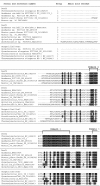A novel Delta9 acyl-lipid desaturase, DesC2, from cyanobacteria acts on fatty acids esterified to the sn-2 position of glycerolipids
- PMID: 16689682
- PMCID: PMC1550309
- DOI: 10.1042/BJ20060039
A novel Delta9 acyl-lipid desaturase, DesC2, from cyanobacteria acts on fatty acids esterified to the sn-2 position of glycerolipids
Abstract
Acyl-lipid desaturases are enzymes that convert a C-C single bond into a C=C double bond in fatty acids that are esterified to membrane-bound glycerolipids. Four types of acyl-lipid desaturase, namely DesA, DesB, DesC, and DesD, acting at the Delta12, Delta15, Delta9, and Delta6 positions of fatty acids respectively, have been characterized in cyanobacteria. These enzymes are specific for fatty acids bound to the sn-1 position of glycerolipids. In the present study, we have cloned two putative genes for a Delta9 desaturase, designated desC1 and desC2, from Nostoc species. The desC1 gene is highly similar to the desC gene that encodes a Delta9 desaturase that acts on C18 fatty acids at the sn-1 position. Homologues of desC2 are found in genomes of cyanobacterial species in which Delta9-desaturated fatty acids are esterified to the sn-2 position. Heterologous expression of the desC2 gene in Synechocystis sp. PCC 6803, in which a saturated fatty acid is found at the sn-2 position, revealed that DesC2 could desaturate this fatty acid at the sn-2 position. These results suggest that the desC2 gene is a novel gene for a Delta9 acyl-lipid desaturase that acts on fatty acids esterified to the sn-2 position of glycerolipids.
Figures




Similar articles
-
DesC1 and DesC2, Δ9 Fatty Acid Desaturases of Filamentous Cyanobacteria: Essentiality and Complementarity.Plant Cell Physiol. 2024 Jun 27;65(6):975-985. doi: 10.1093/pcp/pcad153. Plant Cell Physiol. 2024. PMID: 38147500
-
delta 9 Acyl-lipid desaturases of cyanobacteria. Molecular cloning and substrate specificities in terms of fatty acids, sn-positions, and polar head groups.J Biol Chem. 1994 Oct 14;269(41):25576-80. J Biol Chem. 1994. PMID: 7929259
-
Cloning of omega 3 desaturase from cyanobacteria and its use in altering the degree of membrane-lipid unsaturation.Plant Mol Biol. 1994 Oct;26(1):249-63. doi: 10.1007/BF00039536. Plant Mol Biol. 1994. PMID: 7524725
-
Structure and Function of Δ9-Fatty Acid Desaturase.Chem Pharm Bull (Tokyo). 2019;67(4):327-332. doi: 10.1248/cpb.c18-01001. Chem Pharm Bull (Tokyo). 2019. PMID: 30930436 Review.
-
Structure, function, and dietary regulation of delta6, delta5, and delta9 desaturases.Annu Rev Nutr. 2004;24:345-76. doi: 10.1146/annurev.nutr.24.121803.063211. Annu Rev Nutr. 2004. PMID: 15189125 Review.
Cited by
-
Heterologous Expression of PA8FAD9 and Functional Characterization of a Δ9-Fatty Acid Desaturase from a Cold-Tolerant Pseudomonas sp. A8.Mol Biotechnol. 2016 Nov;58(11):718-728. doi: 10.1007/s12033-016-9971-9. Mol Biotechnol. 2016. PMID: 27629791
-
Possible involvement of extracellular polymeric substrates of Antarctic cyanobacterium Nostoc sp. strain SO-36 in adaptation to harsh environments.J Plant Res. 2022 Nov;135(6):771-784. doi: 10.1007/s10265-022-01411-x. Epub 2022 Sep 15. J Plant Res. 2022. PMID: 36107269
-
Modes of Fatty Acid desaturation in cyanobacteria: an update.Life (Basel). 2015 Feb 16;5(1):554-67. doi: 10.3390/life5010554. Life (Basel). 2015. PMID: 25809965 Free PMC article.
-
Molecular Cloning and Functional Expression of a Δ9- Fatty Acid Desaturase from an Antarctic Pseudomonas sp. A3.PLoS One. 2016 Aug 5;11(8):e0160681. doi: 10.1371/journal.pone.0160681. eCollection 2016. PLoS One. 2016. PMID: 27494717 Free PMC article.
-
Effects of temperature up-shift and UV-A radiation on fatty acids content and expression of desaturase genes in cyanobacteria Microcystis aeruginosa: stress tolerance and acclimation responses.Photochem Photobiol Sci. 2024 Jun;23(6):1167-1178. doi: 10.1007/s43630-024-00584-9. Epub 2024 May 8. Photochem Photobiol Sci. 2024. PMID: 38717721
References
-
- Kenyon C. N., Rippka R., Stanier R. Y. Fatty acid composition and physiological properties of some filamentous blue–green algae. Arch. Mikrobiol. 1972;83:216–236. - PubMed
-
- Wada H., Murata N. Membrane lipids in cyanobacteria. In: Siegenthaler P. A., Murata N., editors. Lipids in Photosynthesis: Structure, Function and Genetics. Dordrecht: Kluwer Academic; 1998. pp. 65–81.
-
- Shanklin J., Cahoon E. B. Desaturation and related modifications of fatty acids 1. Annu. Rev. Plant Physiol. Plant Mol. Biol. 1998;49:611–641. - PubMed
Publication types
MeSH terms
Substances
LinkOut - more resources
Full Text Sources
Molecular Biology Databases

